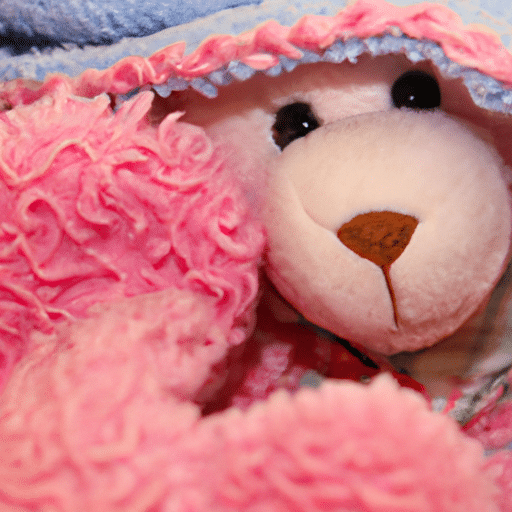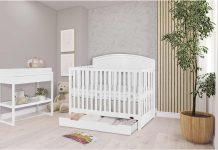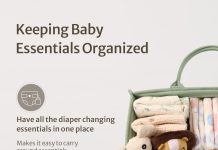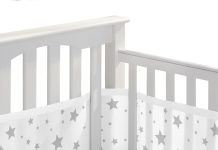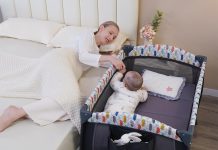Ah, the age-old question that keeps new parents tossing and turning at night – when can a baby finally snuggle up with a cozy blanket? As we venture into the realm of baby sleep essentials, this topic stands as a significant milestone in a little one’s journey towards independence. With safety being our utmost priority, it’s essential to navigate the fine line between comfort and potential hazards. So, let’s pull back the covers and explore when it’s safe to tuck that adorable bundle of joy in with a soft, fluffy blanket.
Review contents
Safety Guidelines for Baby’s Sleep Environment
As parents, ensuring the safety of our baby during sleep is of utmost importance. One key aspect of creating a safe sleep environment for our little ones is to keep the crib bare. This means avoiding any unnecessary items or bedding in the crib that could potentially pose a suffocation or strangulation hazard. By keeping the crib free of pillows, blankets, stuffed animals, and other loose objects, we can significantly reduce the risk of accidents during sleep.
Another important safety guideline is to avoid the use of loose bedding in the crib. While a soft, cozy blanket may seem like a comforting addition to our baby’s sleep environment, it can actually be hazardous. Loose bedding, such as blankets and sheets, can lead to accidental entanglement or suffocation. It is best to adhere to the mantra of “bare is best” when it comes to our baby’s crib.
However, this does not mean that our baby has to go without any form of warmth or comfort during sleep. Sleep sacks or wearable blankets are a great alternative to traditional blankets. These specially designed garments provide the necessary warmth without the risk of entanglement or suffocation. Sleep sacks come in a variety of materials and designs, allowing us to choose the one that best suits our baby’s needs.
Recommended Age for Introducing a Blanket
When it comes to introducing a blanket into our baby’s sleep routine, it is essential to follow the recommendations set forth by the American Academy of Pediatrics (AAP). The AAP advises against the use of blankets in the crib until the baby is at least one year old. This recommendation is based on the potential risks associated with loose bedding, as mentioned earlier.
It is important to note that every baby develops at their own pace, and there might be individual circumstances that warrant a different approach. Consulting with our pediatrician can provide personalized guidance that takes into account our baby’s specific needs and developmental milestones.
Signs of Readiness for a Blanket
While the recommended age for introducing a blanket is around one year old, there are certain signs that can indicate our baby’s readiness for this milestone. One of these signs is the ability to roll over independently. Rolling over is an indication that our baby has enough strength and coordination to move and adjust their position during sleep, reducing the risk of suffocation.
Another sign of readiness is our baby’s ability to adjust their body temperature independently. If our little one can effectively kick off or reach for a blanket to regulate their comfort level, it may be a sign that they are ready for the added responsibility of having a blanket in their crib.
Additionally, if our baby shows a preference for a blanket or demonstrates a desire for extra comfort during sleep, this can also be a sign that they are ready for the introduction of a blanket.
Importance of Baby’s Comfort and Security
Comfort and security play crucial roles in the quality of our baby’s sleep. By providing them with a familiar and comforting object, such as a blanket, we can promote a sense of security and help them develop self-soothing behaviors.
A blanket can serve as a source of comfort, offering warmth and familiarity that can help lull our baby to sleep. This can be particularly beneficial during transitions, such as moving from a bassinet to a crib or transitioning to a toddler bed. The presence of a familiar blanket can ease the anxieties associated with these changes and provide a sense of continuity in their sleep routine.
Furthermore, having a blanket in the crib can encourage our baby to develop self-soothing skills. This means that they can learn to comfort and calm themselves in the absence of our immediate presence. By providing a blanket that they can hold, snuggle, or manipulate, we are empowering them to self-soothe, which can lead to more independent and restful sleep.
Safe Blanket Options for Babies
When selecting a blanket for our baby, it is important to choose a safe option that aligns with the recommended guidelines. Here are a few considerations to keep in mind:
-
Use a lightweight blanket: Opt for a blanket made from breathable and lightweight materials. This helps to prevent overheating and ensures that our baby can easily move and adjust their position during sleep.
-
Opt for breathable fabrics: Choose blankets made from natural fibers, such as cotton or bamboo. These materials allow for better airflow and help regulate our baby’s body temperature.
-
Choose blankets specifically designed for infants: Look for blankets that are specially designed with the safety of infants in mind. These blankets often feature secure stitching, smaller sizes, and appropriate thickness to ensure a safe sleep environment.
By selecting a blanket that meets these criteria, we can provide our baby with a comfortable and safe sleep experience.
Safe Blanket Placement in the Crib
Once we have chosen a safe blanket for our baby, it is essential to ensure proper placement in the crib. The following guidelines can help us create a safe sleep environment for our little one:
-
Place the blanket below the baby’s chest level: To minimize the risk of suffocation, tuck the blanket below the baby’s chest level. This ensures that it does not cover their face during sleep.
-
Ensure the blanket is securely tucked in: Make sure the blanket is tightly tucked in around the sides and bottom of the crib. This prevents it from becoming loose and posing a suffocation hazard.
-
Avoid covering the baby’s face: It is crucial to ensure that the blanket is not covering our baby’s face or obstructing their breathing. Regularly check on our little one to ensure the blanket remains in the intended position.
By following these guidelines, we can ensure that our baby can enjoy the comfort and warmth of a blanket while minimizing any potential risks.
Alternatives to Blankets for Extra Warmth
While blankets can provide warmth, there are alternative ways to keep our baby cozy without the use of loose bedding. Here are a few options:
-
Adjust room temperature: Maintain a comfortable room temperature to ensure our baby’s warmth during sleep. A temperature between 68-72 degrees Fahrenheit (20-22 degrees Celsius) is generally recommended.
-
Layer the baby’s clothing: Dress our baby in appropriate layers of clothing to regulate their body temperature. This allows us to add or remove layers as needed without the potential risks associated with loose blankets.
-
Use sleep sacks or wearable blankets: Sleep sacks or wearable blankets are a safe and convenient alternative to traditional blankets. These fitted garments provide warmth and comfort while eliminating the risk of entanglement or suffocation.
By utilizing these alternatives, we can ensure that our baby stays warm and cozy during sleep without compromising their safety.
Monitoring Baby’s Sleep with a Blanket
Once a blanket has been introduced into our baby’s sleep routine, it is important to monitor their sleep to ensure their comfort and safety. Here are a few tips for monitoring our baby’s sleep with a blanket:
-
Regularly check on the baby: Take frequent peeks into the crib to ensure that the blanket remains safely below the baby’s chest level and is not covering their face.
-
Ensure the blanket remains in the intended position: Throughout the night, make sure that the blanket stays securely tucked in and does not become loose or tangled.
-
Monitor for any discomfort or overheating: Watch for signs of discomfort or overheating, such as excessive sweating, flushed skin, or restlessness. Adjust the room temperature or clothing layers as necessary to ensure our baby’s comfort.
By actively monitoring our baby’s sleep with a blanket, we can address any potential issues and ensure a safe and peaceful sleep environment.
Additional Safety Precautions
In addition to the guidelines already discussed, there are a few additional safety precautions to keep in mind when it comes to our baby’s sleep environment:
-
Avoid using blankets in a bassinet or cradle: While blankets may be appropriate once our baby transitions to a crib, they should not be used in a bassinet or cradle. These smaller sleep spaces have limited airflow and pose a greater risk of suffocation.
-
Wash blankets regularly: Regularly wash the baby’s blankets to keep them clean and free of allergens. Follow the manufacturer’s instructions for proper care and maintenance.
-
Keep blankets away from potential hazards: Ensure that blankets are kept away from any potential hazards, such as cords, blinds, or other objects that could pose a risk of entanglement.
By following these additional safety precautions, we can further enhance the safety of our baby’s sleep environment.
Conclusion
Introducing a blanket into our baby’s sleep routine is a decision that should be guided by both developmental milestones and safety guidelines. By adhering to the recommended age guidelines and consulting with our pediatrician, we can make an informed choice that prioritizes our baby’s well-being.
When the time is right, a blanket can provide comfort, security, and a sense of familiarity for our little ones. By selecting a safe blanket, ensuring proper placement in the crib, and monitoring our baby’s sleep, we can create a cozy and secure sleep environment.
Remember, the safety and comfort of our baby should always be our top priority. By following these safety guidelines and continuously monitoring our baby’s sleep environment, we can help ensure that they have a peaceful and restful night’s sleep.

